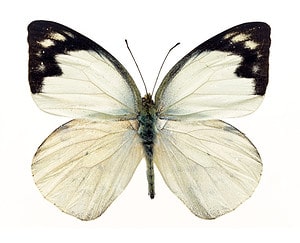The adult butterfly, its impressive wings swathed in all kinds of unique patterns and colors, always provides a pleasant sight as it flits gracefully between flowers, lapping up the nectar with its uncoiled proboscis. These majestic creatures share the same insect order of Lepidoptera with the closely related moths, having evolved more than 200 million years ago. Butterflies rely heavily on their visual sense for survival. Their eyes help them detect predators, navigate around their environment, and find suitable sources of nectar from which they can drink. This article will cover some fascinating details about the number and the structure of the butterfly’s eyes, as well as its visual quality.
How many eyes does the butterfly have?
The answer to the question changes depending on the life stage of the butterfly. Once it exits the egg, the caterpillar stage has 10 to 14 (though usually 12) small eyelets arranged in a semi-circle around the face. However, these very simple eyes only have the capacity to identify light and dark rather than precise images or color. The caterpillar navigates around its environment almost entirely blind, using its other senses to find its way.
After undergoing the transformational process of metamorphosis, the adult butterfly will have two large and fully developed compound eyes, situated on either side of the head. While these are actually fewer eyes than a caterpillar, adult eyes have much better sight overall. The butterfly is hardly unusual in this regard. Two eyes are a common number for most adult insects. It’s actually a misconception that insects tend to have more than two eyes, like spiders, crabs, and other arthropods.
What people might be confused about is the structure of the eye. Unlike the simpler lenses of most animals, the compound eye of the insect is composed of many thousands of different individual photoreceptors. Each receptor effectively has its own individual cornea and lens, but it still operates as part of a single eye. Altogether, each butterfly eye can contain up to 17,000 of these receptors (though many species have fewer).
Another important component of the eye is the photoreceptor cells, which distinguish color and brightness. Whereas in a human eye, there are many light-sensitive cells that work together to form an image (as well as various other mechanisms to control the amount of light entering the lenses), each individual butterfly photoreceptor contains only a few cells for the light to focus on. This actually has a negative effect on the butterfly’s visual quality, but it makes up for this in other ways.

©iStock.com/vmenshov
What is the butterfly vision like?
The compound eye of the butterfly has some serious advantages and disadvantages compared to your average non-compound eye. The most important advantage it confers is the ability to see in many different directions at once. This means the insect eye will remain fixed in place, unable to move, and still achieve a better field of vision than your standard animal eye. For a small, vulnerable animal like an insect, this allows it to act almost instantly the moment it detects a threat.
The major downside to a compound eye, on the other hand, is loss of acuity (meaning quality of vision). Even with lots of individual lenses, the insect eye cannot achieve the same visual acuity as a non-compound eye with a particularly dense arrangement of cells. It’s estimated that the acuity of the human eye is about a hundred times better than even the most high-quality insect eye (which is thought to be the dragonfly with some 30,000 lenses per eye). Compound eyes also lack the ability to focus on objects by controlling the shape of the lens, which means the insects have to move closer or farther away to produce much the same effect.
Butterflies make up for this deficiency in other ways. For instance, compared to most insects, color vision is a very important aspect of the butterfly’s visual repertoire. It enables them to identify and distinguish the correct types of flowers to feed upon in the wild. Butterflies are also better able to distinguish fast-moving objects than humans, which could be very useful in flight. Another important trait is the ability to see beyond the normal range of human vision, including both ultraviolet and polarized light. Ultraviolet light, a strong component of sunlight, is just beyond the visible blue and violet end of the color spectrum, whereas polarized light is often present when the atmosphere scatters sunlight in a particular way. It’s been suggested that some types of insects (including fruit flies and honeybees) may use ultraviolet and polarized light to navigate through the air while in flight.
The key to its wide range of vision might be the types of photoreceptors in its eye. A human eye only has three different types of photoreceptor cells, although this is sufficient to see millions of different colors. Butterflies, by contrast, have at least four different types of receptor cells, and many species have at least six; this allows them to distinguish certain aspects of color and light that humans cannot.
Some butterfly species have truly extraordinary color vision. According to a study published in the journal “Frontiers in Ecology and Evolution,” the male version of the common bluebottle butterfly has 15 different types of photoreceptor cells (the female was not studied, but it’s presumably similar). Greenlight alone seemed to trigger four different receptors, while blue light triggered another three. It’s not entirely clear why it has evolved 15 different receptor cells, but one hypothesis is that it’s related to mating. Since it’s highly sensitive to any variation in the blue-green part of the color spectrum, the male is much more adept at distinguishing fellow blue-colored rivals that may be difficult to spot against the blue sky.

©iStock.com/Svetlana Sinichkina
What are the eyes on the wings?
Those black markings on the wings are called false eyespots. Many butterfly species have at least some version of them; the small blue species from the family of Lycaenidae even have fake heads near the tail with big eyespots and false antennae. These markings obviously aren’t true eyes and cannot provide any vision, but they do serve other important purposes. For a long time, it was thought that these eyespots had evolved to mimic the eyes of more fearsome creatures to fool potential predators and make them think twice about approaching. Another possible hypothesis is that the eyespots deflect attacks away from the head and toward less vulnerable parts of the body. These eyespots also sometimes have a secondary function of attracting mates.
NEXT UP…
- 10 Incredible Butterfly Facts If you love butterflies as much as we do you will enjoy these fun facts!
- Butterfly Predators: What Eats Butterfly? Find out who is hunting for the butterfly.
- What Do Caterpillars Eat? Some caterpillars have a surprising diet.
The photo featured at the top of this post is © KRIACHKO OLEKSII/Shutterstock.com
Thank you for reading! Have some feedback for us? Contact the AZ Animals editorial team.






